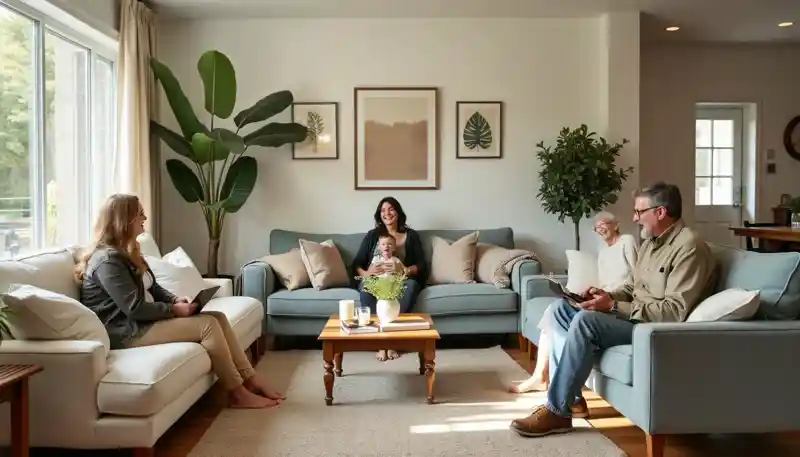Are you struggling with rising housing costs and caregiving expenses? Multigenerational living is growing, with 26% of American adults now sharing homes across three or more generations.
Key Takeaways
- Multigenerational living is growing, with 26% of American adults now sharing homes across three or more generations.
- Smart home designs like D.R. Horton’s “MultiGEN” model offer private zones with separate entrances and shared spaces to balance independence and family time.
- 82% of families report better finances from living together, with savings on utilities, food, and home upkeep that can be used for travel, hobbies, or building nest eggs.
Design Features that Facilitate Multigenerational Living

Smart home design makes multigenerational living easy. Private zones and shared spaces create a balance between independence and family time.
Private zones for independence
Private zones give each family member their own space in multigenerational homes. You’ll find separate living areas with private entrances in D.R. Horton’s “MultiGEN” model. These zones let grandparents, parents, and kids have independence while living under one roof.
Your family can enjoy privacy and freedom with smart design features. Builders now create flexible floor plans that include personal bathrooms, kitchenettes, and separate living rooms.
These private areas help reduce conflicts and allow each generation to maintain their lifestyle within the shared home.
Shared spaces for family activities
Shared spaces bring families closer in multigenerational homes. Living rooms and kitchens become hubs for bonding and making memories. You’ll find grandparents helping with homework, parents cooking family meals, and kids playing board games together.
These common areas foster social connections across generations.
Flexible layouts allow you to adapt spaces as your family’s needs change. You might turn a spare room into a nursery or convert a den into a home office. Universal design features ensure everyone can use these spaces comfortably.
Wide doorways, lever handles, and good lighting make shared areas accessible for all ages and abilities. With smart planning, your home can grow and change with your family.
Financial Advantages of Shared Family Living
Shared family living can slash your bills. You’ll save big on housing costs and everyday expenses.
Reduced per-capita cost of living
You’ll save big when you share a home with family. Living costs drop for everyone. Housing eats up about 35% of your income. But in a multigenerational home, you split that bill.
Shared living trims other expenses too. You’ll spend less on utilities, food, and home upkeep. Plus, you can pool money for bigger purchases or investments.
With smart planning, you could save $50,000 or more yearly. That’s money you can use for travel, hobbies, or building your nest egg.
Shared expenses on utilities and maintenance
Sharing a roof with family can slash your bills. In multigenerational homes, you split costs for power, water, and upkeep. This team effort leads to big savings. Families can cut their yearly expenses by about $50,000 through shared living.
Utility bills shrink when more people chip in. You’ll see lower costs for heating, cooling, and internet. Home repairs also become easier to manage. With multiple incomes, fixing a leaky sink or updating LED lights isn’t as hard on your wallet.
Over half of Americans now enjoy these perks by living with several generations under one roof.
Challenges and Solutions in Multigenerational Homes
Living with multiple generations can be tough. You can solve issues by setting clear rules and creating private spaces for each family member.
Balancing privacy with togetherness
You need both private and shared spaces in multigenerational homes. Create separate areas for each family unit, like bedrooms with en-suite bathrooms. This gives everyone a place to retreat.
Add soundproofing to walls and floors for extra privacy. For togetherness, design open living areas and kitchens. These spaces encourage family bonding and shared meals.
Smart home tech can help balance privacy and togetherness. Use smart bulbs and lamps to control lighting in different zones. Install nightlights in hallways for safety without disturbing others.
Set up a shared calendar on tablets or smartphones to coordinate schedules. This way, you can plan family time while respecting each other’s personal space.
Managing different lifestyle needs
Balancing privacy and togetherness sets the stage for managing different lifestyle needs in multigenerational homes. Families must adapt to various routines and preferences under one roof.
Customizable designs in accessory dwelling units (ADUs) can meet specific family needs. For instance, you might install a stovetop in a separate living area for an older parent who enjoys cooking.
Or, you could create a quiet study space for school-age grandchildren. The key is to plan for future needs. As families grow and change, so do their living requirements. By considering these factors early, you’ll create a home that serves everyone well for years to come.
Conclusion: Maximizing Savings and Harmony in Multigenerational Households
Multigenerational homes offer a smart solution for families seeking financial relief. You can save up to $50,000 yearly by sharing costs and resources. These homes blend private areas with shared spaces, fostering both independence and togetherness.
With careful planning, you’ll create a living space that meets everyone’s needs while cutting expenses. This innovative approach to housing can lead to stronger family bonds and a brighter financial future for all generations involved.
FAQs
1. How does living with three generations under one roof save families money?
Families can save on child care, dental care, and housing costs. Great-grandparents can help with kids, reducing daycare fees. Shared living spaces cut housing expenses. This setup can save families up to $50,000 yearly.
2. What are secondary suites and how do they help in multi-generational living?
Secondary suites are separate living areas within a home. They give privacy to each generation. These spaces can include small apartments or triplexes. They help families live together while maintaining independence.
3. How can the “sandwich generation” benefit from this living arrangement?
The sandwich generation cares for both children and aging parents. This setup allows them to provide attention to both groups. It eases the burden of care and reduces costs for things like cognitive decline support and teeth cleaning.
4. Are there any financial considerations when setting up a multi-generational home?
Yes, families should consider refinancing options, homeowners’ association rules, and potential surcharges. They may need to work with a broker to navigate these issues. It’s important to factor in all costs, including potential royalty fees for certain home designs.
5. How does this living arrangement impact dental care for the family?
With shared living, families can pool resources for dental care. They can find affordable dentists through services like Delta Dental. Regular check-ups become more manageable, helping prevent cavities and other issues. This setup can significantly reduce overall healthcare costs.
References
- https://lifeathome.ikea.com/blog/under-one-roof-the-secrets-to-success-for-multi-generational-living/
- https://www.nar.realtor/magazine/real-estate-news/home-and-design/all-under-one-roof-trends-in-multigenerational-living (2024-07-16)
- https://academythinkinteriordesign.medium.com/multi-generational-living-design-designing-spaces-for-families-with-different-age-groups-f3316bcf8527
- https://www.commercebank.com/personal/ideas-and-tips/2024/advantages-of-multigenerational-living (2024-01-29)
- https://www.ncbi.nlm.nih.gov/pmc/articles/PMC5769098/
- https://www.ksat.com/news/local/2024/07/17/families-combat-rising-costs-by-living-under-one-roof-study-shows/ (2024-07-17)
- https://www.agegracefullyamerica.com/under-one-roof-the-advantages-of-multigenerational-households/






